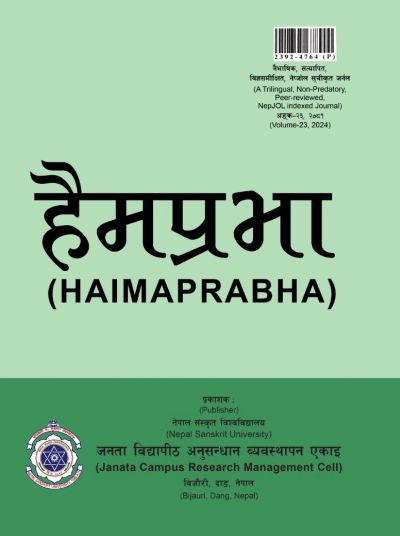पोखरेली कविका हाइकुमा प्रकृति
DOI:
https://doi.org/10.3126/haimaprabha.v23i1.66720Keywords:
अनसभव, आलङ्कारिक, ऋतुशब्द, किगो, हाइकुAbstract
प्रस्तुत अनुसन्धान पोखराबाट प्रकाशित हाइकुसङ्ग्रहका हाइकुमा प्रकृतिको चित्रण कस्तो छ भन्ने समस्यामा केन्द्रित छ । सङ्ग्रहभित्रका हाइकुमा प्रयुक्त प्रकृतिको चित्रण नै अनुसन्धानको मुख्य उद्देश्य रहेको छ । अनुसन्धानलाई पूर्णता दिन सामग्री सङ्कलनमा पुस्तकालयलाई प्रमुख स्रोत मानिएको छ । पोखराबाट प्रकाशन भएका हाइकुसङ्ग्रह अनुसन्धानका प्राथमिक स्रोत हुन् । हाइकुका माध्यमबाट अभिव्यक्त भएको प्रकृति बिम्ब विश्लेषणका आधार हाइकुका तत्त्व भएकाले त्यस सम्बन्धमा विभिन्न विद्वान्ले अगाडि सारेका चिन्तन एवम् दृष्टिकोणलाई द्वितीय स्रोत सामग्रीका रूपमा उपयोग गरिएको छ । गुणात्मक अनुसन्धान ढाँचामा केन्द्रित रहेर तयार पारिएको आलेखमा सूक्ष्म पठन तथा विश्लेषण विधि प्रयोग गरी निष्कर्ष निकालिएको छ । अनुसन्धानमा हाइकुमा प्रकृतिको वस्तुपरक चित्रण भन्दा प्रकृतिका दृश्य, स्पर्श, ध्वनि, सुगन्धका साथै स्वादलाई मानवीकरण गरेर बिम्बात्मक, प्रतीकात्मक र आलङ्कारिक रूपमा प्रस्तुत गरिएका छन् । यी विविध विषयमध्ये हाइकुमा अभिव्यक्त दृश्य बिम्बको अध्ययन गरी विद्यमान वास्तविकताको वस्तुसत्य निरीक्षण र सामाजिक सत्यको निरूपण गरी अनुसन्धानको निष्कर्ष प्रस्तुत गरिएको छ ।
[The presented research focuses on the problem of how nature is depicted in the haiku of the haiku collection published in Pokhara. The primary goal of the study is to examine how nature is portrayed in the collection's haiku. A library is thought to be a valuable resource for gathering information needed to finish research. The haiku collection published from Pokhara is the primary source of research. As the basis of analysis of the nature image expressed through haiku is the elements of haiku, the thoughts and viewpoints put forward by various scholars have been used as secondary source material. In the article prepared focusing on qualitative research framework, conclusions have been drawn using micro reading and analysis method.Instead of the objective portrayal of nature in haiku, the research humanizes and presents the sight, touch, sound, smell, and taste of nature in metaphorical, symbolic, and symbolic ways.]
Downloads
Downloads
Published
How to Cite
Issue
Section
License

This work is licensed under a Creative Commons Attribution 4.0 International License.
© Nepal Sanskrit University, Janata Campus, RMC, Bijauri Dang, Nepal

